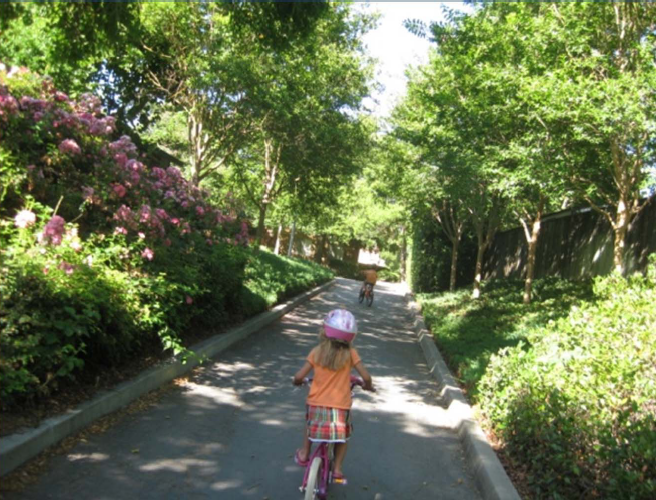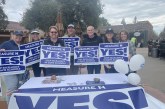
The City Council earlier this year voted to place a measure on the June 5, 2012 ballot which will renew the existing Parks Maintenance Tax.
The city staff has developed “a Frequently Asked Questions (FAQ) sheet to answer questions [to] provide background information for voters or others who may be interested in learning about the ballot measure.”
According to this week’s staff report, “In keeping with State law, the City can only provide factual information about any ballot measure; it cannot advocate for or against a measure, or fund support/opposition to a measure.”
Nevertheless, the proposed FAQ sheet, which does not have a ballot designation, serves as a good starting point to understand the city’s rationale for putting forward the tax at this point.
What is the Parks Maintenance Tax?
[The Parks Maintenance Tax] is a City ballot measure to renew the current Parks Maintenance Tax that was first approved by voters in 1998. It was renewed by 79% of the voters in 2002 and 70% of the voters in 2006. If approved by at least two-thirds of the voters in June 2012, Measure __ would again renew the current Parks Maintenance Tax at the same rate of $49 annually for residential parcels and $40 per 1,000 sq. ft. for non-residential parcels, not to exceed a maximum of 10,000 sq. ft. If approved, the tax would be subject to renewal in six years (2018).
Measure __ will be on the June 5, 2012 ballot. It requires a two-thirds (66.67%) vote to pass. It includes the same refund for low-income residents as the current Parks Maintenance Tax. The ballot measure reads as follows:
Ballot Language:
Shall Ordinance No. ____, which extends for six years the existing Parks Maintenance Tax of $49 per year of residential units and on non-residential units in amounts specified in the Ordinance, to fund maintenance of parks, street trees, greenbelts, bike paths, medians, public landscaping, urban wildlife and habitat, swimming pools, and recreational facilities be adopted?
Is this a new tax and how much is it?
No, this is not a new tax. It has appeared on property tax bills since 1998. Measure __ would renew the existing Parks Maintenance Tax at the same rate of $49 per residential parcel and $40 per 1,000 sq. ft. for non-residential parcels.
Why does the City have a Parks Maintenance Tax?
In 1991, the City first levied the Landscape and Lighting Assessment District (LLAD) to help offset General Fund expenditures for the maintenance of parks, greenbelts, street trees, and related facilities. In 1992, the State of California began to take additional local property taxes from cities to help fund state programs, such as K-12 education. The State then cut its own funding to schools in the same amount. The net effect of this shift in tax revenue, known as the Educational Revenue Augmentation Fund (ERAF), has grown to over $2.5 million per year in lost General Fund dollars for the City of Davis. Cumulative revenue loss from property tax shifts to date is approximately $36 million.
local property taxes from cities to help fund state programs, such as K-12 education. The State then cut its own funding to schools in the same amount. The net effect of this shift in tax revenue, known as the Educational Revenue Augmentation Fund (ERAF), has grown to over $2.5 million per year in lost General Fund dollars for the City of Davis. Cumulative revenue loss from property tax shifts to date is approximately $36 million.
The Landscape and Lighting District remained in effect until 1998, when the passage of Proposition 218 changed the requirements for the LLAD. The City replaced the LLAD with a voter-approved Parks Maintenance Tax. In 1998, the Parks Maintenance Tax passed by 78%, with a four year sunset. In 2002, the Parks Maintenance Tax was renewed by 79% of the voters, with a four year sunset. In 2006, the Parks Maintenance Tax was renewed by 70% of the voters, with a six year sunset.
The City maintains “Special Funds,” which can only be used for specific purposes, such as the federal, state and county grants that the City administers. The Parks Maintenance Tax is considered to be a Special Fund because it can only be spent on parks maintenance and related amenities. The General Fund, on the other hand, is the primary funding source for City services, such as general government, recreation programs, the majority of parks maintenance, fire services and police protection. Having the Parks Maintenance Tax assist with the maintenance of parks, greenbelts, trees and pool complexes frees General Fund dollars to spend on other City services.
How does the City use the revenue from the Parks Maintenance Tax?
The Parks Maintenance Tax provides $1.37 million annually, which is dedicated to assisting with the maintenance of parks, greenbelts, open spaces, pools, streetscapes, and trees. As a special tax, revenues must be spent only for these purposes. Having a dedicated Parks Maintenance Tax means that the City can rely less on General Fund revenues to provide park maintenance, which allows additional funding for other City services, such as general government, other recreation and community programs and services, fire services and police protection.
Since the initial Parks Maintenance Tax went into effect in 1998, the City has added several parks and greenbelts, streetscapes, street trees, and a pool complex. Within the last ten years, the maintenance of three community parks (Arroyo, Mace Ranch, and Walnut), John Baravetto Neighborhood Park, the Arroyo pool complex and approximately 43 additional acres of greenbelts and open space have been added. Today, the existing tax pays for 25%, with 75% being paid for by the General fund.
Why is Measure __ on the June 2012 Ballot for renewal?
The Parks Maintenance Tax was approved by 78% of the voters in 1998, renewed by 79% of the voters in 2002, renewed by 70% of the voters in 2006, and sunsets in June 2012. The City Council has placed Measure __on the ballot to ask residents to continue to pay the Parks Maintenance Tax. Loss of the Parks Maintenance Tax would have a $1.37 million impact on the City’s budget starting in July 2012.
In addition to placing Measure __ on the June 2012 Ballot, the City continues to seek long-term funding solutions to ensure that expenditures do not exceed revenues. To do this, the City is looking at ways to become more efficient with the services we provide, the appropriateness of the current levels of service, and ways to increase revenue to the City. Revenues may include taxes, economic development projects, and grants.
Why isn’t the City seeking an increase over the current amount of $49/year?
The City continues to seek a long-term solution to address its structural budget shortfalls. The City Council decided that, until a more comprehensive solution can be developed and implemented, continuation of the Parks Maintenance Tax at its current level of $49/year is a prudent interim solution to sustain City services.
The City Council is interested in working with the community to develop viable long-term strategies to sustain and enhance vital services for Davis residents. These long-term strategies could include economic development, continuing efforts to improve efficiencies, improving non-tax revenues, and exploring other revenues such as taxes. If the long-term strategies include different tax measures, then those will be brought before the voters at the earliest possible date. The City Council must evaluate the different types of tax measures and other strategies to determine what makes the most sense to the community. Until such time, the City Council believes that the renewal of $49 parcel tax is an appropriate mechanism to use.
Why can’t the City apply the Parks Maintenance Tax based on assessed value of the property?
By law, the City of Davis is not allowed to assess a parcel tax based on the value of the property. The California State Constitution provides that property tax is the only tax that is legally allowed to be levied based on the assessed value of a parcel.
Why does the tax sunset in six years?
The City Council decided that six years would give the City adequate time to develop, approve and implement comprehensive and viable long-term financial strategies. At the same time, the sunset acknowledges that the Measure is not proposed as a permanent tax.
Why doesn’t the City use the General Fund reserve instead of renewing the Parks Maintenance Tax?
The City maintains a “reserve” much like an individual or household would keep a savings account accessible for an emergency. The City Council has adopted a policy to have a General Fund reserve equal to 15% of the City’s General Fund revenues. This is a contingency reserve for general operations to help mitigate the effects of unanticipated situations such as recession, man-made or natural disasters, variances in financial forecasting, or costs imposed by other governmental agencies. The City does not use the reserve to fund ongoing services, such as those funded by the current Parks Maintenance Tax.
The General Fund reserve can fluctuate from year to year. The City is continuing to seek a long-term solution to align expenditures and revenues in order to prevent the reserve from being depleted, and using the General Fund reserve instead of renewing the Parks Maintenance Tax would exacerbate the problem.
How does renewal of the Parks Maintenance Tax fit into the City’s overall financial strategy?
The City Council continues to place fiscal stability as a primary goal. Fiscal stability is achieved through (1) increased efficiencies and cost savings, (2) economic development, and (3) determination of appropriate user fees and other revenue enhancements. The City Council proposed renewal of the Parks Maintenance Tax as one component of the current base revenue.
Since the last renewal of the Parks Maintenance Tax in 2006, the City Council has worked with the community to address each of the elements of the City’s overall financial strategy:
Increased Efficiencies and Cost Savings. The City constantly seeks ways to deliver services more efficiently and effectively:
- Performing audits of departments to seek potential streamlining measures
- Increasing use of volunteers to provide City services (Examples: Police Volunteers, Graffiti Abatement, Tree Planting)
- Implementing technology and web-based services, which can decrease staff costs (Example: Online crime reporting; recreation registration, and utility bill payments; wireless field reporting by police officers)
- Extending the life of equipment (Examples: Delaying the purchase of new fleet vehicles)
- Leasing city-owned facilities to generate revenue (Examples: Long-term leasing of Varsity, Historic City Hall and Community Pool)
- Using reduced staffing levels while work load demands and infrastructure steadily increased
- Reducing program expenditures in order to balance the operating budget
Economic Development. Council has supported and/or approved projects aimed at expanding and diversifying the City’s sales tax and business base. The City Council continues to make improvements to the downtown, such as infrastructure improvements on Second, Third and E streets, and to provide an atmosphere where local businesses can thrive and expand, thus contributing to the City’s tax base.
Equitable and Reasonable Fees. The Council continues to review and revise fees in City programming to ensure that fees reflect both the costs to the City and the benefit to the community. Development fees are also reviewed and updated annually so that any growth in the City pays its fair share of development-related expenses.
Sustained and Enhanced Revenue. In 2010, voters renewed a half-cent sales tax, which contributes approximately $2.9 million year to the City’s General Fund. This sales tax revenue is used to pay for some of the City’s general services. Revenues from the half-cent sales tax provided 8% of the City’s General Fund revenue in fiscal year 2010-2011.
Council will continue to work with the community to consider broad-based revenue strategies. If the Council, in partnership with the community, envisions other revenue strategies for providing and enhancing necessary City services, these new measures will be presented to the voters in future elections.
What has been the State’s impact on the City?
Since 1992, the State Legislature has taken General Fund property tax revenue away from cities and counties. As a result, Davis has lost nearly $36 million in tax revenue. The City of Davis receives, on average, less than 18% of the property tax generated within city limits. In addition, the State has fluctuated in its commitments to the City for other revenues, such as Vehicle Licensing Fees, funding for road improvements, child care programs, community policing programs, and reimbursement of State-mandated costs. The State also passed legislation which required the City to dissolve its Redevelopment Agency, which had been a primary source of funding for economic development and affordable housing activities. State actions continue to cause fiscal strain and uncertainty to the City.
What will happen if the Parks Maintenance Tax is not renewed?
If the Parks Maintenance Tax is not renewed in 2012, the City will need to determine how to reduce services and costs in response to the loss of approximately $1.3 million. Although the $1.3 million is dedicated to assisting with the maintenance of parks, greenbelts, open space, street trees, and pool complexes, reductions could come from any City service or program that is funded by the General Fund, including parks, greenbelts, pools, police, fire, and other recreation and community services and programs. The City Council is currently reviewing budget reduction options should Measure __ fail. Such program reductions could be implemented as early as July of 2012.
Vanguard Commentary:
There are several different big pictures to this issue.
The first picture is laying out the tax environment this year. The school district is looking to renew their parcel tax, with a CPI (Consumer Price Index) inflator. That election is coming up in two months.
The voters in November will be asked to weigh in on the water rate hikes – there will, at the very least, be an advisory vote with a Prop 218 process. Of all of the taxes and fees, that is potentially by far the largest. The previous proposed increase was a minimum 26.7% per unit rate increase, that might have been reduced with conservation efforts.
The parks tax, by contrast, is very modest, at $49 per year.
The second picture that needs to be laid out is the city’s fiscal picture. The city passed the extension of the sales tax in 2010 and is now looking to pass the parks tax in 2012.
The tax funds only about a quarter of the ongoing parks costs, and that fits into the general problem of under-funded elements of the budget.

As we have noted, the city is underfunded right now by at least $1 million in terms of pensions, $2.4 million in terms of Other Post-Employment Benefits, another $2 million in street maintenance and another nearly half million in concrete repair. They are also underfunded in parks facilities replacement costs.
We estimated that the city was going to have to find about $7 million in cuts to be able to keep up with funding for pensions, OPEB and streets. That is a huge chunk of change.
For several years we have been talking about the need to have a community discussion on what our spending priorities have to be. We have to understand that the big ticket items are public safety, public works and parks.
One of the things that we have consistently argued for is finding private partnerships, either in the form of private companies or non-profits, to take over some of the city-sponsored recreation functions, including pools and rec programs.
At the same time we are leery of the overall tax burden and believe that parks are an area where we should be looking to cut back on the spending – $6 million on maintaining parks is, simply put, too much. We also have been cognizant that the number we will cut back to on parks is not zero.
Given that the parks tax only funds a quarter of the actual costs, we believe that is a reasonable amount.
Moreover, we have to applaud this council for their fiscal responsiveness. One of the big things that they passed a few months ago was a measure by which unmet needs, which previously were put into an off-budget category much like a wish list, will now be fully reflected in the budget and will demonstrate the gap in spending that the city has.
The council was wise at this point to avoid any increase in the parks tax, either by an actual rate increase or a CPI inflator.
Based on all of this, the Vanguard urges the city to look at ways to cut into that $6 million annual operating cost, but at this time believes renewing the tax makes the most sense, particularly in light of the general fund hit that would occur due to the loss of $1.36 million at this time.
—David M. Greenwald reporting






[quote]Moreover, we have to applaud this council for their fiscal responsiveness. One of the big things that they passed a few months ago was a measure by which unmet needs, which previously were put into an off-budget category much like a wish list, will now be fully reflected in the budget and will demonstrate the gap in spending that the city has.[/quote]
Well said…
Agreed. DG, good job on this.
[quote]the city is underfunded right now by at least [b]$1 million[/b] in terms of pensions, [b]$2.4 million[/b] in terms of Other Post-Employment Benefits, another [b]$2 million[/b] in street maintenance and another nearly [b]half million[/b] in concrete repair[/quote]
[quote]We estimated that the city was going to have to find about $7 million in cuts to be able to keep up with funding for pensions, OPEB and streets[/quote]There’s a ~ $1 Million dollar difference in the above… is that your estimate of the missing Park’s piece?
Kudos to the Council for also recognizing a past mistake and rectifying it in advance of this parcel tax vote; that being the reinstatement of the Parks and Rec half-time IPM (Integrated Pest Management) position that was lost during last summer’s budget cuts. The Council refunded the position in its consent calendar during its last meeting.
The Council wisely recognized that the environmental community in Davis was not going to support a tax extension unless continued progress was made in reducing pesticide usage in our parks and pathways. The exisiting IPM specialist was doing a great job implementing least toxic options throughout the Parks system which progress came to a ginding halt and was actually reversed during his 6 month hiatus.
Hopefully progress can now start to be renewed and our parks can be as safe as possible for our kids.
hpierce: That $7 million figure accounts for expected PERS increases in the next three years.
Just a heads up – the State of California is starting to enforce a little known rule that homeowners can only apply a deduction on their taxes for the actual assessed value. Taxes for Parks, schools, etc. that are a flat fee per property can no longer be deducted. In the past, people were deducting 100% of their property tax bill on their federal and state returns. Starting this year, the Franchise Tax Board is going to be checking to make sure only the taxes on the assessed value of the home is deducted. This applies to the Open Space tax, all the schools taxes and the Parks tax. People will no longer be able to deduct these “donations.”
http://www.sfgate.com/cgi-bin/article.cgi?f=/c/a/2012/02/05/BUG61N2O5K.DTL
Thanks Ryan for the heads up. So in addition to the approx. $2000 in local taxes per household in Davis we can no longer deduct that figure so homeowners are looking at an additional $300 to $700 they’ll have to pay in Federal taxes and an additional $100 to $200 in state taxes depending on their tax bracket.
So these school tax measures, parks tax, and all other local taxes put on your homeowners tax bill are no longer going to be deductible as the authorities are going to crack down. The article says that legally they never were deductible, but almost everyone took the entire deduction anyway and the state never really enforced the law. Now things are changing. I wonder how many people in Davis know this? Will this hurt the passage of Measure C?
http://www.sfgate.com/cgi-bin/article.cgi?f=/c/a/2012/02/05/BUG61N2O5K.DTL
Folks are STUPID… if the tax is $1,000 per year… if you’re at a 25% tax marginal rate, and you are itemizing, and can’t take the tax as a deduction, that means you’d be paying $250 more a year… ~ $12 / month… most are not in the 25% marginal rate. Bogus argument, in my opinion. I’m more concerned as to whether the levies exist, rather than the tax consequences
Should have made clear… for those who do not benefit from itemizing…. none of the taxes “in play” have NO EFFECT on State/Federal tax liabilities…
“that means you’d be paying $250 more a year… ~ $12 / month..”
Next time when you proclaim that “folks are STUPID”, you may want to check your math before hitting the ‘add comment’ button.
Most people who pay homeowners tax do itemize. I just checked my tax bill and local levies not based on the value of my home come to $1920.
Using your 25% marginal tax rate figure that comes to $480/yr. or
$40/month. These figures don’t even count the extra state taxes that will be due. Now we’re talking some money that will definitely hurt many homeowners.
People paying Mello Roos will be hardest hit as they will no longer be able to deduct that portion of their property tax bill.
I was speaking only to the proposed school & City parks tax levies and the tax increment… the city-wide and Mace Ranch MR taxes are in place, and yes, this IRS approach could be devastating. But, if it occurs, the school & parks tax levies “deduct-ability” will literally be drops in the bucket.
But a donation to the Davis Schools Foundation was deductible. We went with the $200 schools tax in order to avoid the fundraising nightmare every year. Now our “donations” are not tax-deductible. People should know this.